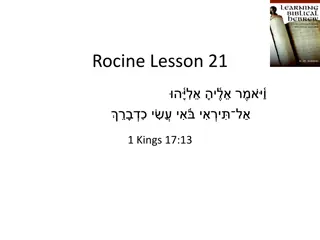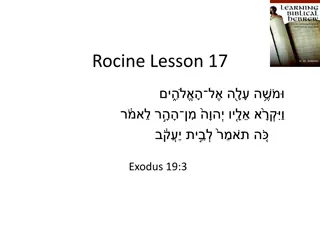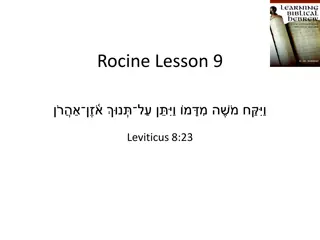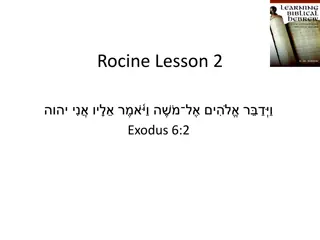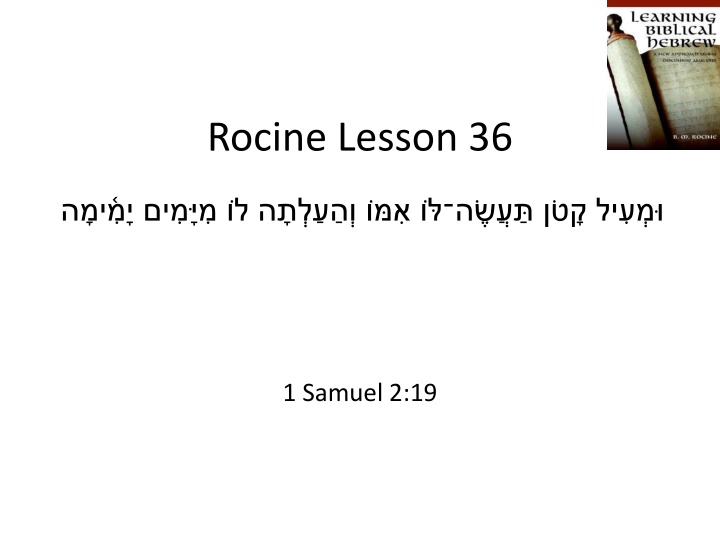
X-Yiqtol Construction in Procedural Discourse
Explore the concept of X-Yiqtol construction in procedural discourse, focusing on Qal and Hiphil verb forms, Discourse Switch Cues (DSCs), and the functions of waw-consecutive and waw-conjunctive in Biblical Hebrew grammar.
Download Presentation

Please find below an Image/Link to download the presentation.
The content on the website is provided AS IS for your information and personal use only. It may not be sold, licensed, or shared on other websites without obtaining consent from the author. If you encounter any issues during the download, it is possible that the publisher has removed the file from their server.
You are allowed to download the files provided on this website for personal or commercial use, subject to the condition that they are used lawfully. All files are the property of their respective owners.
The content on the website is provided AS IS for your information and personal use only. It may not be sold, licensed, or shared on other websites without obtaining consent from the author.
E N D
Presentation Transcript
Rocine Lesson 36 1 Samuel 2:19
Goals Identify and read the X-yiqtol construction in Procedural Discourse in the Qal and Hiphil qatal and yiqtol Discourse Switch Cues (DSCs)
X-Yiqtol and Procedural Discourse means a small cloak. Is the waw waw-consecutive? waw-conjunctive?
Waw-consecutive Waw-conjunctive Waw-consecutive Waw-consecutive RULE: The vav s which are part of the mainline verb forms are called vav-consecutive. The vav-consecutive means and, but and also has the special discourse function of linking together the string of events which make up the mainline of a discourse. The vav-consecutive indicates that the action of the verb is the consequence of the preceding situation.
Waw-conjunctive Waw-conjunctive Waw-consecutive Waw-consecutive RULE: Conjunctive (or disjunctive) vav may be attached to almost any word, including a verb form, and means and, but like the vav-consecutive, but it does not have the additional function of stringing together actions in a sequence. We call this vav conjunctive when its clause adds depictive or explanatory material to the mainline and it is best translated and. We call it disjunctive when its clause is used for contrastive purposes, and it is best translated but.
X-Yiqtol and Procedural Discourse Waw conjunctive A noun phrase
X-Yiqtol and Procedural Discourse Waw So we have an X-yiqtol. conjunctive Yiqtol A noun phrase
X-Yiqtol and Procedural Discourse Waw So we have an X-yiqtol. conjunctive Yiqtol A noun phrase If this verse was in a +projection / forward looking / direct speech genre, where weqatal is the mainline verb form, what would be the function of the X-yiqtol?
X-Yiqtol and Procedural Discourse Waw So we have an X-yiqtol. conjunctive Yiqtol A noun phrase If this verse was in a +projection / forward looking / direct speech genre, where weqatal is the mainline verb form, what would be the function of the X-yiqtol? Topicalization (non-past)
X-Yiqtol and Procedural Discourse Waw So we have an X-yiqtol. conjunctive Yiqtol A noun phrase Procedural Discourse also has weqatal as the mainline verb form, so it s not surprising that the X-yiqtol will have a function similar to what it does in +projection genres. But it is has a narrower, more specificed, function in Procedural Discourse.
X-Yiqtol and Procedural Discourse Waw So we have an X-yiqtol. conjunctive Yiqtol A noun phrase In the +projection genres, the yiqtol describes an event in the future, a singular event a repeated event or an incipient event (i.e. the beginning of a process.) In Procedural Discourse, the yiqtol describes an event in the past, but it describes a repeated or habitual action
X-Yiqtol and Procedural Discourse Waw So we have an X-yiqtol. conjunctive Yiqtol A noun phrase RULE: A yiqtol verb form, when used in a main clause rather than a dependent clause in Procedural Discourse, refers to repeated or habitual action in the past. Translate using the English word would.
X-Yiqtol and Procedural Discourse Let s parse the two verbs. Root Stem Form PGN Function Root meaning
X-Yiqtol and Procedural Discourse Let s parse the two verbs. Root Stem Form PGN Function Root meaning Procedural Discourse Topicalization (past repeated/habitual action) Qal X-Yiqtol 3fs To do
X-Yiqtol and Procedural Discourse Let s parse the two verbs. Root Stem Form PGN Function Root meaning Procedural Discourse Topicalization (past repeated/habitual action) Qal X-Yiqtol 3fs To do To go up (hiph: to bring up) Procedural Discourse Mainline (customary action in the past) Hiphil Weqatal 3fs
X-Yiqtol and Procedural Discourse Let s parse the two verbs. Root Stem Form PGN Function Root meaning Procedural Discourse Topicalization (past repeated/habitual action) Qal X-Yiqtol 3fs To do To go up (hiph: to bring up) Procedural Discourse Mainline (customary action in the past) Hiphil Weqatal 3fs Notice that in this genre, these 2 verb forms have basically the same function. The difference is that the X-yiqtol syntax also topicalizes the X element.
X-Yiqtol and Procedural Discourse ? Waw conjunctive One more thing. What kind of waw is on the weqatal? Consecutive or conjunctive?
X-Yiqtol and Procedural Discourse ? Waw conjunctive One more thing. What kind of waw is on the weqatal? Consecutive or conjunctive? I m not sure. In the past I would have considered this a waw-conjunctive, because it s certainly not a waw- conversive, i.e. a waw that converts a perfect to a future. But it could perhaps be considered a waw- consecutive. There may be some confusion here due to conflicting or inadequate approaches to describing the Hebrew verb system.
Conjugating in Qal and Hiphil Look at the chart in Rocine 36.2 (page 207) In the Qal Qatal Where is the verb weak? At the front end or back end? What changes from the strong verbs do you see? In the Hiphil Qatal Where is the verb weak? What changes do you see from the strong verb? Is the prefix vowel consistent? Is the theme vowel consistent? Is anything consistent? What are its chief indicators?
Conjugating in Qal and Hiphil Look at the chart in Rocine 36.2 (page 207) In the Qal Yiqtol Where is the verb weak? At the front end or back end middle? What changes from the strong verbs do you see? In the Hiphil Yiqtol Where is the verb weak? At the front end or back end middle? What changes from the strong verbs do you see? What forms are the same with the Qal Yiqtol?
Expressions using doesn t always mean a 24 hour period or the 12 hours of daylight. In this verse in the plural refers to the cycle of years. Translate it literally
Expressions using doesn t always mean a 24 hour period or the 12 hours of daylight. In this verse in the plural refers to the cycle of years. Translate it literally from days to days
Expressions using doesn t always mean a 24 hour period or the 12 hours of daylight. In this verse in the plural refers to the cycle of years. Translate it literally from days to days We know from context that it is referring to an annual event, so we can translate it from year to year.
Expressions using 1 Samuel 2:19 the yearly sacrifice 1 Genesis 26:8 And when he had been there a long time 2 Genesis 38:12 And in the course of time 3 Genesis 43:9 forever 4 1 Samuel 18:10 day by day 5 Exodus 5:13 the daily task 6 2 Samuel 13:23 And after two years 7 Judges 19:2 a time of four months 8
Discourse switch cues A Discourse Switch Cue (DSC) is a signal to the reader that there is a switch in genres. So far the major switch has been to direct speech and the main DSC has been Procedural Discourse is not marked by a switch to direct speech, but there are other cues used by the Hebrew writer to notify his reader that he is switching to an embedded Procedural Discourse.
Discourse switch cues A Biblical Hebrew writer uses a Discourse Switch Cue (DSC) to aid his reader in realizing that the genre has changed. Examples Any speech introduction. A shift from a string of one mainline type (e.g. wayyiqtol) to another (e.g. weqatal or imperative). An X-yiqtol within a string of wayyiqtols. Expressions of time duration.
Discourse switch cues A Biblical Hebrew writer uses a Discourse Switch Cue (DSC) to aid his reader in realizing that the genre has changed. Examples Any speech introduction. A shift from a string of one mainline type (e.g. wayyiqtol) to another (e.g. weqatal or imperative). An X-yiqtol within a string of wayyiqtols. Expressions of time duration. Which 2 are used in our lesson verse?
Discourse switch cues A Biblical Hebrew writer uses a Discourse Switch Cue (DSC) to aid his reader in realizing that the genre has changed. Examples Any speech introduction. A shift from a string of one mainline type (e.g. wayyiqtol) to another (e.g. weqatal or imperative). An X-yiqtol within a string of wayyiqtols. Expressions of time duration. Which 2 are used in our lesson verse?
Discourse switch cues An isolated X-yiqtol in a Historical Narrative may be considered a mini Procedural Discourse. Try translating 1 Kings 17:6. wadi raven
Discourse switch cues An isolated X-yiqtol in a Historical Narrative may be considered a mini Procedural Discourse. Try translating 1 Kings 17:6. wadi raven And the ravens were bringing him bread and meat in the morning and bread and meat in the evening, and it was from the brook that he would drink.
Historical Narrative Discourse Profile 1. Mainline: Wayyiqtol Off-the-line: 2. Topicalization: X-qatal 3. Embedded Direct Speech 4. Relative past background: Qatal in dependent clause 5. Non-past background: Yiqtol in dependent clause 6. Backgrounded activities: Participle 7. Embedded Procedural Discourse 8. Transition marker: Mainline form of 9. Scene setting: Verbless Clause 10.Irrealis scene setting: Negation of any verb
Historical Narrative Discourse Profile 1. Mainline: Wayyiqtol Off-the-line: 2. Topicalization: X-qatal 3. Embedded Direct Speech 4. Relative past background: Qatal in dependent clause 5. Non-past background: Yiqtol in dependent clause 6. Backgrounded activities: Participle 7. Embedded Procedural Discourse 8. Transition marker: Mainline form of 9. Scene setting: Verbless Clause 10.Irrealis scene setting: Negation of any verb Background: ongoing Related Background: habitual/customary

